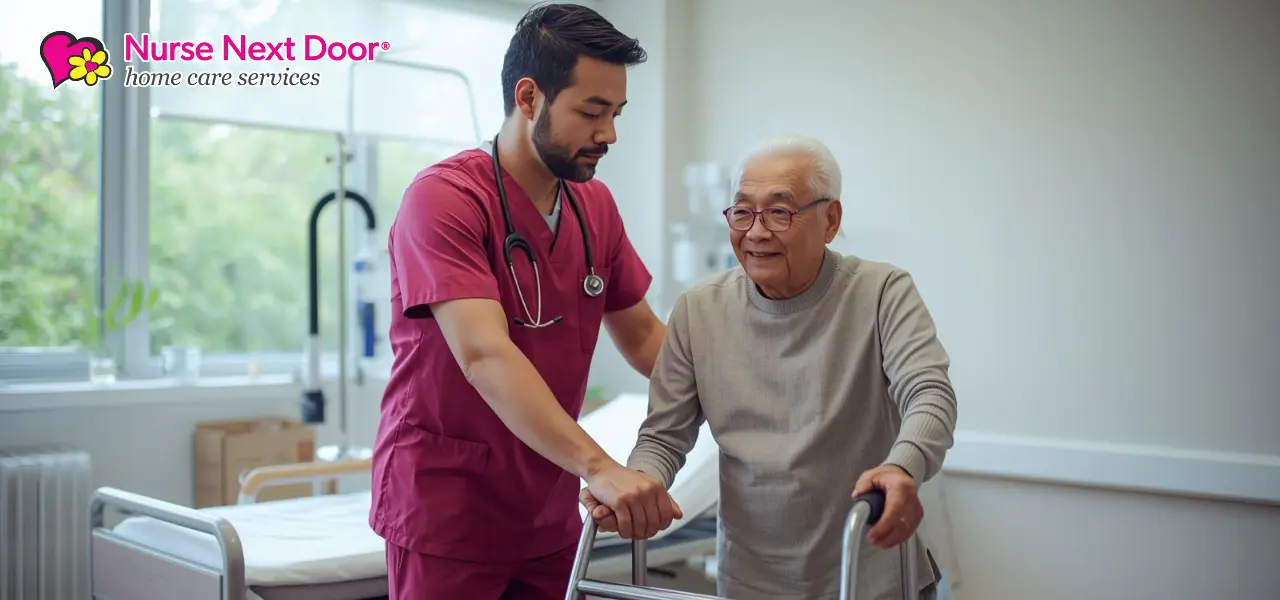
Around 70 hip fractures occur every minute in individuals over the age of 55, according to statistics published by the International Osteoporosis Foundation. Besides this, 1 in every 3 women and 1 in every 5 men over the age of 50 will experience a hip fracture. In the US, the total number of annual hip fracture cases is approximately 340,000, and most of them are seniors. These statistics highlight the need for timely and effective physical therapy by home health care providers like Nurse Next Door McLean. Let’s explore some of the most effective measures for post-hip fracture rehabilitation in McLean.
Do you want to recover fast and regain mobility through physical therapy in the comfort of your home? Book a free Caring Consult with Nurse Next Door McLean.
Top Benefits of Home Care in Virginia, USA
Understanding Post-Hip Fracture Rehabilitation in McLean
You need to start rehabilitation efforts within 24 hours of undergoing surgery after you have experienced the fracture. A surgeon can manipulate your bone back into a position where it will heal, but you have to make sure your joint stays active and useful.
Being dependent on someone else can be an extremely depressing and disturbing experience, and hip fracture rehab is at the center of avoiding that. Good post-hip fracture rehabilitation in McLean means reduced chances of disability.
Role of Physical Therapy
Physical therapy plays a huge role because without it your muscles and bones may not get back in shape and support your weight. The hip joint is your largest weight-bearing joint, and it undergoes stress during activities like walking and running. Even standing upright requires a healthy and stable hip joint. Physical therapy can help you with:
- Getting back on your feet as soon as possible. You need to attempt walking soon after your surgery (based on your doctor’s advice) – even if it’s uncomfortable or your leg feels heavy. It’s best to have a professional available around you when you attempt this, but the sooner you try to walk, the more chances you have of regaining normal mobility.
- Increasing the number of steps you walk day by day. You need to progressively strength-train your legs. That means that you will start with very little and gradually increase the amount of force you put on your hip joint.
- Performing exercises to help you balance your body better and maintain your gait. A hip fracture can compromise both of these and physical therapy can save you from living with an odd gait.
- Carrying out different tasks in your daily routine.
Physical therapy helps prevent future disability and reduces your risk of a repeat hip fracture. With its devastating effects on mobility, a hip fracture often leads to the patient sustaining a second hip fracture soon after the first one because they’re bed-bound or can’t walk very well if they skip proper post-hip fracture rehabilitation in McLean.
Evidence of Effectiveness
A study found that patients who regularly exercise their hip joints within 3 months of surgery have much better mobility compared with those who don’t. Another research found that exercises that challenge balance are highly effective at preventing subsequent falls and potential trauma in the future. Even as few as 3 visits from a physiotherapist have been found to make a difference in mobility after hip fracture repair.
Selecting the Right Home Health Care for Seniors
Challenges and Recovery Timeline
For patients who stay bedridden during recovery, muscle atrophy causes the most problems. When you don’t use your muscles, they tend to lose mass and they can’t work as well when they’re being used after a long time. Your body automatically reduces nutritional investment in the parts of it that you aren’t using! That’s why it’s so important to get off your bed and move around after a hip fracture.
This is the expected recovery timeframe:
| Timeframe | Expected Progress / Focus |
| First few days | Assisted sitting, gentle movement, transfers, walking with aid |
| First 1–3 weeks | Increase walking distance, strength exercises, ADL* practice |
| 1–3 months | Gait normalization, balance work, functional independence |
| 3–6 months | Maximizing strength, endurance, community reintegration |
*ADL is a term that stands for “Activities of Daily Living”, which are frequently compromised after a hip fracture.
Consider In-Home Physical Therapy in McLean
For people looking for post-hip fracture rehabilitation in McLean, help isn’t very far out of reach. Nurse Next Door McLean has trained, experienced, and licensed physical therapists who are ready to pay you a visit at your home and give you the first highly effective physical therapy session. They specialize in dealing with such injuries and procedures and you can call them at any time. After the initial evaluation, they create a personalized physical therapy plan for you, and you perform various exercises under the supervision of a qualified physical therapist. Schedule the first life-changing visit now.



